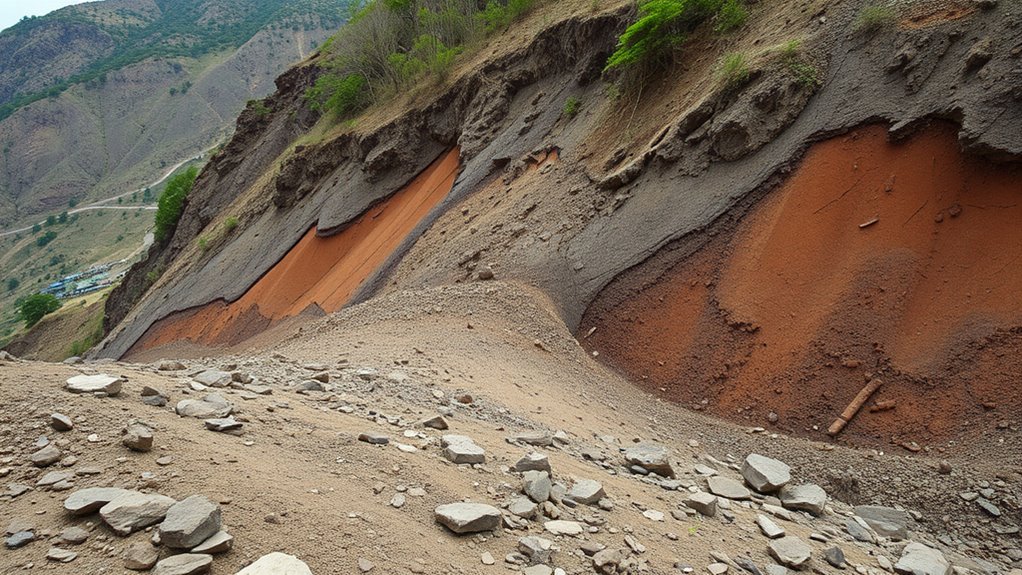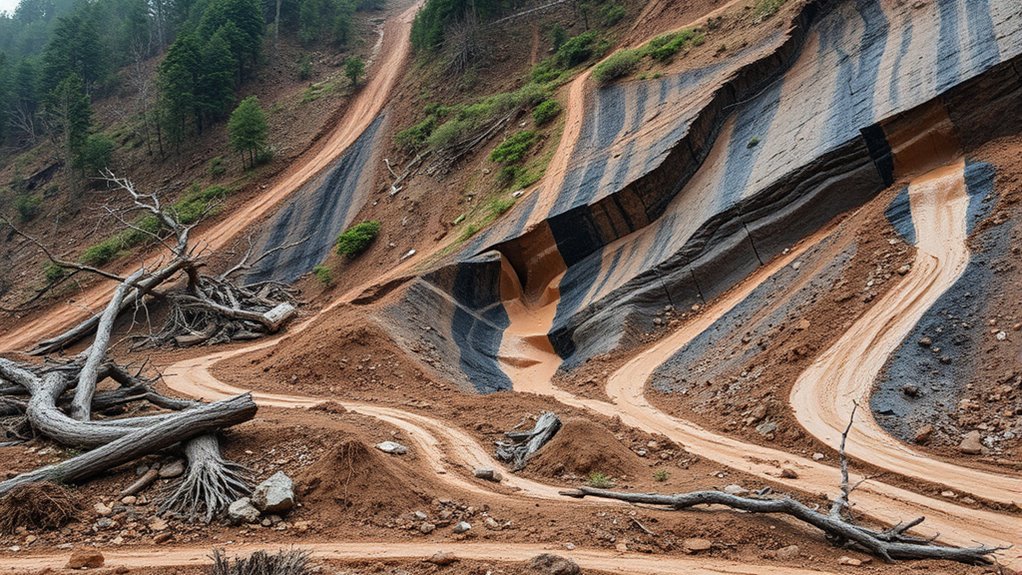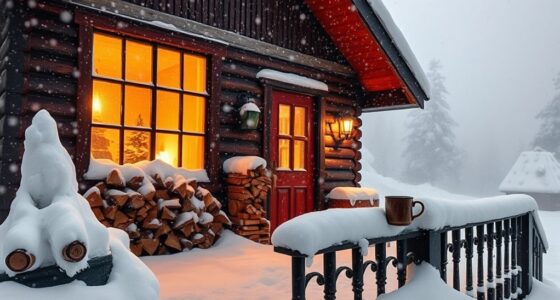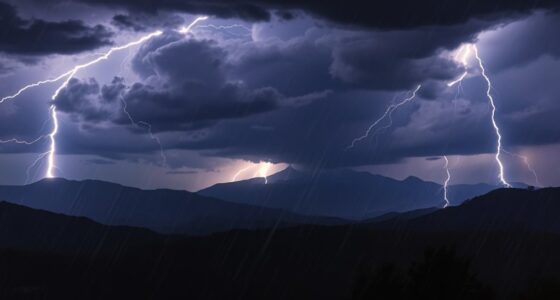To spot potential landslides and mudflows, watch for cracks in ground or walls, leaning trees, bulging slopes, loose debris, and pooling water at slope bases. Keep an eye on signs like heavy rain, rapid snowmelt, or rising rivers that weaken soil. Listen for faint rumbling, and stay alert during or after bad weather. Recognizing these subtle clues can help you act quickly—if you keep paying attention, you’ll learn how to stay safe.
Key Takeaways
- Monitor slopes for cracks, bulges, or uneven patches indicating early ground shifts.
- Be alert to water pooling, mud accumulation, or fallen rocks signaling increased landslide risk.
- Recognize environmental signs like heavy rain, rapid snowmelt, or saturated soil that weaken slopes.
- Listen for sounds such as rumbling or faint roars from hillsides, which may precede slides.
- Stay informed through weather alerts and evacuate promptly if signs of instability appear.

Landslides and mudflows are powerful natural events that can cause widespread destruction and threaten lives and property. When you’re in an area prone to these hazards, understanding how to recognize the early signs can make all the difference. The first step is to pay close attention to the landscape around you. Steep slopes and loose soil are prime conditions for a slide, especially after heavy rain or rapid snowmelt. If you notice cracks appearing on the ground, walls, or pavement, take them seriously. These small fractures can be warning signs that the ground is shifting beneath your feet. Similarly, if trees or poles are tilting or shifting unexpectedly, it indicates instability in the soil.
You should also observe the surface of the slope itself. Look for any unusual bulges or uneven patches that seem out of place. These can be early indicators that the ground is moving. In areas with loose debris or fallen rocks, be aware that a small shift could trigger a larger slide. If you see mud or water pooling at the base of a slope, it might be a sign that the ground is saturated and more likely to give way. During or after heavy rain, the risk increases markedly, so it’s vital to stay alert. In some cases, you might notice a faint roar or rumbling coming from the hillside—these sounds can precede a landslide or mudflow, especially if the ground is loose and unstable.
Reading the signs isn’t just about spotting physical changes; it also involves understanding the weather conditions. Heavy rain, rapid snowmelt, or even the overflow of nearby rivers can weaken the soil structure, making landslides more probable. If you’re in a mountainous or hilly region, you should stay informed through local alerts and forecasts. When you see signs of instability, it’s best to evacuate the area if possible and move to higher ground or a safe location. Additionally, understanding the importance of attention in creative practice can help you stay alert and recognize subtle changes in your environment, which is crucial during potential hazards.
Preparation is key. Know the terrain and have an emergency plan ready. Keep an eye on local warnings and listen for updates from authorities. If you’re caught in a landslide or mudflow, your priority should be to get out of its path quickly. Seek shelter above the expected flow line if you can, and avoid valleys or low-lying areas where mud and debris tend to accumulate. Recognizing the signs early helps you stay safe and potentially avoid disaster altogether.
Frequently Asked Questions
How Can Urban Areas Better Prevent Landslide Damage?
You can better prevent landslide damage in urban areas by implementing strict land-use regulations, avoiding construction on unstable slopes, and maintaining proper drainage systems. Regularly inspecting hillsides for signs of instability and planting deep-rooted vegetation helps stabilize soil. Educate residents about early warning signs and risks, and invest in retaining walls or barriers where necessary. These proactive measures reduce the likelihood of landslides and protect communities effectively.
What Are the Long-Term Environmental Impacts of Mudflows?
Have you ever wondered how mudflows affect the environment over time? These events can strip away vegetation, leading to soil erosion and habitat loss. They also introduce sediments into water bodies, harming aquatic life and reducing water quality. Long-term, mudflows can disrupt ecosystems, alter landscapes, and hinder plant and animal recovery. Are we doing enough to prevent these impacts? Implementing sustainable land management can help protect our environment from ongoing damage.
Are There Specific Seasonal Patterns for Landslides Worldwide?
Yes, seasonal patterns influence landslides worldwide. You’ll find they often occur during or after heavy rains in spring and fall, when soil becomes saturated and unstable. In winter, melting snow can trigger slides in colder regions, while dry, hot summers may cause soil to crack and slide. By understanding these patterns, you can better anticipate risks and stay alert during vulnerable seasons, especially after intense weather events.
How Effective Are Current Early Warning Systems for Mudflows?
Ever wonder if early warning systems for mudflows really work? They’re quite effective, especially when integrated with real-time monitoring like rainfall data, slope stability sensors, and weather forecasts. You can receive alerts that give you vital time to evacuate or prepare. However, their success depends on proper maintenance, accurate data, and community awareness. When all these elements align, early warning systems greatly reduce risks and save lives.
Can Climate Change Increase Landslide Risks Globally?
Yes, climate change can increase landslide risks worldwide. As temperatures rise, heavy rainfall becomes more frequent and intense, saturating slopes and destabilizing them. Warmer conditions also cause snow and ice to melt faster, adding water to slopes and triggering landslides. Droughts can weaken soil stability, and extreme weather events disrupt ecosystems that normally hold slopes together. You need to stay alert, especially in vulnerable areas, to protect yourself from these hazards.
Conclusion
Now that you know the signs, stay alert on those slopes. A sudden shift or a faint crack could be more than just a warning — it might be the last signal before disaster strikes. Don’t ignore the clues nature gives you. Keep your eyes open, act quickly, and never underestimate the power of a landslide or mudflow. The next warning could come when you least expect it — are you ready to respond?










